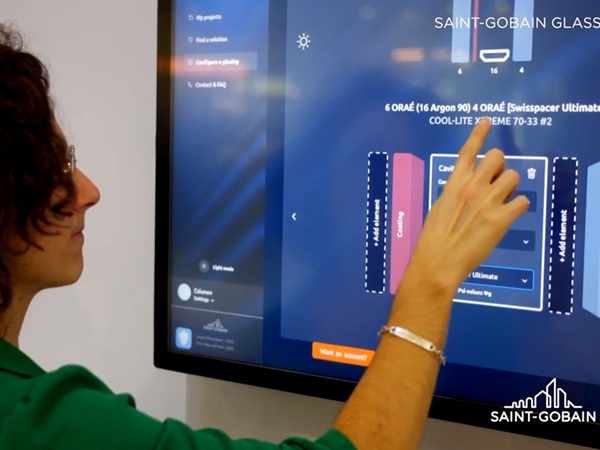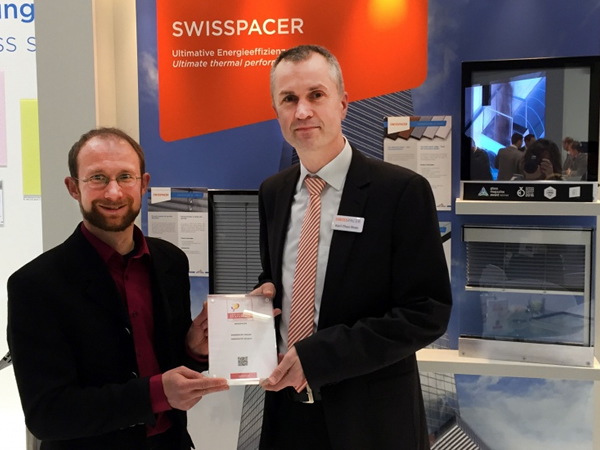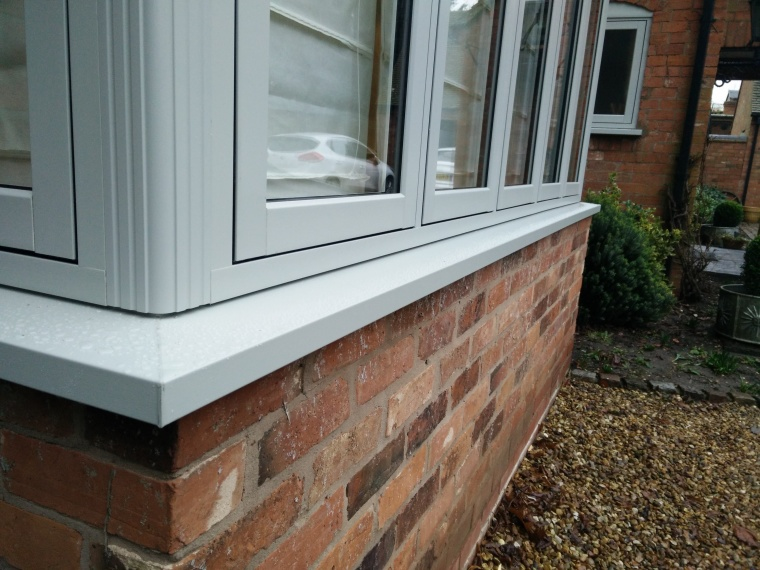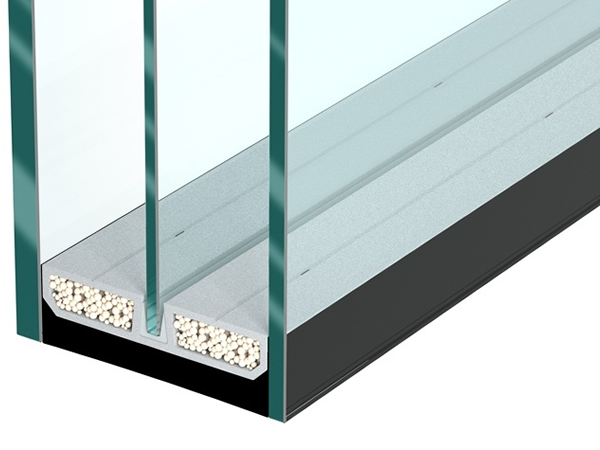Date: 11 November 2013
The organisers did just this: more than 90 experts from across Europe attended this event in the Alsace city of Strasbourg. “fenestra-vision”JPG" />Andreas Geith, CEO of Swisspacer, appealed to the audience in his introduction: “We have to learn how to use energy more carefully and how to build sustainably” Saint-Gobain supports this concept with its Habitat platform for the development of innovative construction materials and energy efficiency solutions. “Swisspacer is committed to supplying the best possible warm edge spacer bars to capitalise on the energy saving potential of windows and facades, and to make a contribution to climate protection,” added Andreas Geith.
“With fenestra-vision, we wanted to bring together experts from a wide variety of fields to network and discuss new ideas for improved energy efficiency in the building trade.”
Developing buildings with a positive energy balance by 2020Alain Maugard, President of the French certification authority Qualibat, a recognised expert and visionary in the French construction sector, examined the “2020 energy balance” in his presentation. In his opinion, environmental factors are just as important as the issue of energy. The global trend towards urbanisation and the formation of new, larger cities is leading to ever-growing problems. The greenhouse effect and water consumption are just two of these problems. On the other end of the scale, there is a push for zero-energy or even positive-energy buildings in Europe. This places greater demand on the construction industry to produce high-performance building envelopes to improve energy performance. But Maugard asked whether this approach is sufficient considering new construction accounts for just 1 percent of the total building stock. What about improving existing buildings’ energy efficiency? “Here in particular, windows are the most cost-effective way of improving insulation, energy generation and ventilation. This means that good times are coming for the window industry,” Maugard predicts.
Model of an innovative certificateJérôme Carrié, Secretary General of the Cekal, introduced listeners to the world of glass and glazing certification.
He pointed out that ift Rosenheim is cooperating with the French Cekal Association. The institute is now authorised to carry out the corresponding laboratory testing and monitoring for multiple-pane insulated glass in Germany as well as in Central and Eastern Europe. Certification meets the requirements of the EN 45011 standard.
Twice a year, the products are tested by independent third parties such as the CSTB (Centre Scientifique et Technique du Bâtiment), Ginger CEBTP (Centre Expérimental de Recherches et d'Études du Bâtiment et des Travaux Publics) and now also ift Rosenheim.
Energy-efficient building envelope – prospects and limitsProf. Ulrich Sieberath, Head of ift Rosenheim, started out by reviewing some visionary buildings and their influence on technical developments in the construction industry. He confirmed that the sector has made far-reaching technical progress. According to Prof. Sieberath, we will soon reach the technical (and therefore the ecological and economical) limits of windows in terms of heat insulation. He sees added potential for windows with composite and box designs, and in particular for the use of solar energy. In his opinion, the industry therefore urgently needs to look at new characteristics beyond U-values, such as the energy label, in order to better position its products.
Prof. Sieberath went on to explain that the weight per unit area of insulated glass has increased steadily, which is why new compositions with thinner panes and plastic films or polycarbonate as centre layers are currently being studied.
Beyond good energy performance, new, more advanced windows require sealing on the inside, insulated frames and, particularly for renovations, a ventilation concept. “However, aluminium spacers no longer have a place in these advanced systems.
Only warm edge spacers make sense here.”
Sieberath explained that better energy gains, accessibility, safety and sustainability are needed from the window of the future. On the other hand, he pointed out that this is going to make windows far more complicated and raised the question: “Are users going to accept this?”
In conclusion, he emphasised that “the future belongs to plus-energy construction and that requires corresponding windows.”
Glazing: a key role in the building of the futureProf. Dr. Wolfgang Feist of Innsbruck University and the Passivhaus Institute presented the concepts and the particularities of the passivhaus standard. According to Feist, the focus is not only on potential energy savings. He also wants to ensure a high level of living comfort for the end users in terms of room and surface temperatures as well as hygiene. From his perspective, the window is a key component since the glass edge is the thermal weak point in the building. However, with triple glazing, frame insulation and high-quality warm edge spacers, temperatures at the glass edge can be increased for effective protection against condensation and the growth of mould. The conclusion drawn by Prof. Feist was: “Aluminium spacers really should be banned. With insulated glass, the positive impact of warm edge on living quality is so great that it has to become the accepted system.”
The Passivhaus Institute has also examined the optimum glazing type, frame and edge composition for windows in many different climate regions around the world. When the costs that could be calculated after the broad implementation of this glazing type are assessed, quadruple glazing turns out to be the most economical solution for large parts of Central and Eastern Europe. Prof. Feist pointed out that triple glazing is economically viable today. Buildings that are highly shaded or lack optimum orientation – existing buildings in particular – will demand further optimization of window components (better insulating glasses, the best warm edge spacers and narrower frames with better U-values).
Until quadruple glazing can be supplied at an acceptable price, Feist says window manufacturers can manage it in the meantime with a combination of two double glazing panes or a combination of one double and one triple glazed pane. Ug-values of 0.3 with g-values of 45% can be achieved if in addition to these measures, low-e coatings on the outside panes are used.
A European energy label for windowsProf. Dr. Franz Feldmeier from Rosenheim University of Applied Sciences spoke about this topic.
The EU Directive 2010/30 for the Labelling of Energy-Related Products calls for rainbow labels on windows, such as those used on washing machines and refrigerators.
While windows do not consume energy, they make a contribution to a building’s energy efficiency. According to Feldmeier, evaluating this effect is now the greatest challenge.
The scientific basis is provided with the ISO 13790 and ISO 18292 standards. However, losses and gains need to be assessed. Concrete climate conditions and concrete buildings and all the specifics must be defined. This is only possible and meaningful for a limited region. For Europe, with its different climate zones, this is very difficult since identical products would then receive different classifications.
Instead of evaluating a window in a defined building at a specific site, Prof. Feldmeier sees the solution in classifying the energy efficiency of the window itself.
For a fair evaluation of the window, it would therefore be sufficient to calculate the energy efficiency on a typical heating day (winter day) and a typical summer day. A “day simulation” according to EN 13370 would be sufficient. This results in an energy indicator for heating and cooling demand for this typical day in kWh/m²d. The daylight indicator can also be specified. Particularities such as the installation situation, variable sun protection or temporary heat insulation are easy to take into account. The limits of the efficiency classes still needs to be established. These could be based on representative window compositions common in Europe.
The energy label developed by ift Rosenheim is based on the rules of EU Directive 2010/30 and pursues product labelling with no influence of the regional climate. This would make windows directly comparable according to the principle: “one window – one classification”.
“We are optimistic that this concept is going to become accepted,” says Prof. Dr. Feldmeier.
Where do we find the building potential for 2015? Forecast of construction output in Germany & Europe and the effects on the window market. Martin Langen, CEO of the company B+L Marktdaten based in Bonn shared his outlook for the European construction and window market for the next three years with the audience. He predicted that Eastern Europe will continue to gain market share.
By far, the largest markets for residential construction in Europe are Russia and Turkey. A total of 1.46 million residential units will be constructed in these two countries in 2013. The total for Germany, France, Italy and Great Britain is only 0.8 million in comparison. While a small growth is expected for residential construction in Germany until 2015, some significant decreases are on the horizon for France, Poland and Benelux. The picture is similar for non-residential construction. Growth of 21% is expected for Russia by 2015, while a 27% increase is forecast for Turkey.
Approximately 143 million windows were sold annually in Europe over the last four years, with about half in Eastern Europe and half in Western Europe in 2009. The East has made significant gains since 2010 and will sell approximately 80 million windows in 2016, with only 63 million in the West by comparison.
According to Martin Langen, there will not be any major shifts in the frame material used for windows. There will only be a minor increase in the share of PVC windows in Western Europe by 2016 at 54%. A minor decrease in the share of PVC windows to 71% is expected in Eastern Europe. Wood and wood-aluminium windows will retain a share of around 25% in Western Europe, while they do not play a major role in Eastern Europe. They will experience a slight decrease with a share of approximately 10%. The proportion of aluminium windows will remain mostly unchanged in Western Europe at approximately 21% of the market, while a slight rising trend is expected in Eastern Europe at around 19%.
Martin Langen also presented the results of his current renovation study and discussed the criteria that are important for end users when buying windows and front doors. According to the study, the replacement of windows and front doors accounts for approximately 15% of all planned building renovation work. Saving money by reducing heating costs was given as the most important reason for replacing windows and doors. Aside from that, the most popular types of home improvement among the respondents were replacing flooring and renovating bathrooms. But where do renovators get their information from when choosing new windows and exterior doors? The study shows that half of the respondents used exhibitions in specialised window trade stores, 38% researched it themselves online and 30% attended exhibitions at DIY stores. Remarkably enough, 30% of the total respondents also read window manufacturers’ brochures and 20% read distributors’ brochures. And where on the internet do renovators search for windows and exterior doors? The study shows that 25% of all respondents look at the window manufacturers’ websites and 22% on the pages of window distributors. Who advises the buyers on windows and front doors? Fitters and installers are the leading source of advice (54%), followed by sales staff at specialised window dealers (27%) and then friends and family (25%).
What age groups are buying windows? Here the study reveals a clear trend: While only around 30% of buyers were 46-65 years old in 2010, this number climbed to 41% by 2012. Among other things, this is due to the rising income potential of this age group since the years with a high birth rate (1960-1970) are now reaching their highest income level.
This target group represents an opportunity for window manufacturers to also sell higher-end solutions at higher prices.
Of course glass – the future of a fascinating material Andreas Bittis, Building Consultant at Saint-Gobain Glass in Aachen, provided the participants with an initial look at the new world of glass.
Andreas Bittis, Building Consultant at Saint-Gobain Glass in Aachen, provided the participants with an initial look at the new world of glass.
First he highlighted what light and glass have in common: “Light is essential for nature and nature responds to light. But it is also there for us – for our pure enjoyment, for wellbeing, essential for life through the production of vitamin D. Glass which gives us a unique link between two worlds, has the same characteristics: it allows us to see through it and interact with nature but it also protects us from rain, cold and noise.
Glass can help shrink the “ecological footprint”, in other words reduce CO2 emissions. Today the energy performance of a building and its facade are key issues. If Ug-values are not as good, the frame profile or even the λ-value (Lambda-value) of the facade insulation has to compensate for this.
It is a little known fact that cast glass has the characteristic of “unlimited light refraction” and contributes to 3% higher efficiency in solar collectors. The particularly high light transmission of this glass in the UV-B radiation range offers ideal growing conditions for plants in greenhouses, for example. The multiple award-winning BIQ “algae house” in Hamburg with its bioreactor facade uses cast glass to “turbocharge” the green algae floating in the space between the panes. Here too it contributes to 3% higher efficiency. The energy produced by the algae is apparently sufficient for the building’s under-floor heating.
According to Bittis, there are two important trends in glass coating: Modern solar control glass is increasingly being described by means of selectivity, the ratio between light transmission (LT-value) and energy transmission (g-value). New developments are attempting to drive this selectivity beyond “2”. Bittis announced the COOL-LITE®XTREME 50/22 product with a selectivity of 2.27 (LT-value 50%, g-value 0.22, U-value 1.0), will launch in 2013.
On the other hand, heat insulation glass with triple glazing is reaching its limits in terms of weight and size. “This is why the goal was to develop double glazing with the heat insulation value of triple glazing,” says Bittis. He believes that the double-glazed insulating glass CLIMAPLUS®Ultimate with a Ug-value of 0.8 W/m²K (LT-value 75%, g-value 0.53) could be available by mid-2014. This innovation was received with great interest by the window manufacturers at the symposium, who described it as a sensational solution to the weight problem.
The engineer and building consultant presented various visionary facades hinting at the future possibilities of glass: video technology in a glass facade by integrating an LED matrix between the panes. Or glass as an active light source with LED strips mounted on the pane and a layer of enamel on the glass to dissipate the light. Or auto-dimming (electrochromatic) glass as sun protection and tinting. This glass when exposed to a low-level current can change from transparent to a dark tint without impairing visibility.
In conclusion, Bittis reminded listeners to leave the smallest possible ecological footprint. In this context, he discussed the integrated approach of Eco-Innovate (Multi-Comfort) with Saint-Gobain products.
Expert session and farewell
The final round of discussions with the speakers, which was moderated by Prof. Dr. Feldmeier, made it clear that the topics raised by the symposium are important issues for the participants, even beyond European boundaries.
There is further need for discussion and networking between researchers, the industry, universities and specialist institutes. This will help develop new ideas, converge different points of view and familiarise an ever-growing segment of the population with the theme.
Andreas Geith thanked the participants and closed the European symposium on energy-efficient windows and facades – fenestra-vision.







Add new comment